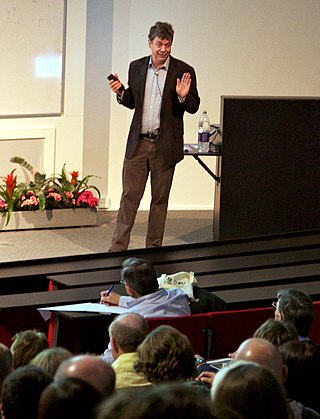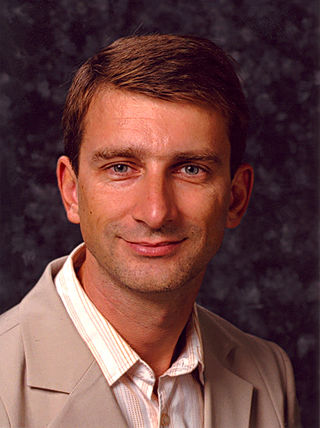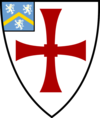
The Niels Bohr Institute is a research institute of the University of Copenhagen. The research of the institute spans astronomy, geophysics, nanotechnology, particle physics, quantum mechanics, and biophysics.

Astrophysics is a science that employs the methods and principles of physics and chemistry in the study of astronomical objects and phenomena. As one of the founders of the discipline, James Keeler, said, Astrophysics "seeks to ascertain the nature of the heavenly bodies, rather than their positions or motions in space–what they are, rather than where they are." Among the subjects studied are the Sun, other stars, galaxies, extrasolar planets, the interstellar medium and the cosmic microwave background. Emissions from these objects are examined across all parts of the electromagnetic spectrum, and the properties examined include luminosity, density, temperature, and chemical composition. Because astrophysics is a very broad subject, astrophysicists apply concepts and methods from many disciplines of physics, including classical mechanics, electromagnetism, statistical mechanics, thermodynamics, quantum mechanics, relativity, nuclear and particle physics, and atomic and molecular physics.
Marc Davis is an American professor of astronomy and physics at the University of California, Berkeley. Davis received his bachelor's degree from the Massachusetts Institute of Technology in 1969, his Ph.D from Princeton University in 1973 and has been elected to both the National Academy of Sciences (1991) and the American Academy of Arts and Sciences (1992). He taught for a year at Princeton, 1973–74, then was on the astronomy faculty at Harvard from 1975 to 1981. Since 1981, he has been on the faculty of the Department of Astronomy and Physics at the University of California at Berkeley.

Carlos Silvestre Frenk is a Mexican-British cosmologist. Frenk graduated from the National Autonomous University of Mexico and the University of Cambridgeand spent his early research career in the United States, before settling permanently in the United Kingdom. He joined the Durham University Department of Physics in 1986 and since 2001 has served as the Ogden Professor of Fundamental Physics at Durham University.
Peter Coles is a theoretical cosmologist at Maynooth University. He studies the large scale structure of our Universe.
Richard Massey is a physicist currently working as Royal Society Research Fellow in the Institute for Computational Cosmology at Durham University. Previously he was a senior research fellow in astrophysics at the California Institute of Technology and STFC Advanced Fellow at the Institute for Astronomy of the University of Edinburgh. Massey graduated in Maths and Physics from the University of Durham in 2000 and was a member of Castle. He completed his Ph.D. at Cambridge in 2003, with a thesis entitled Weighing the Universe with weak gravitational lensing.

Simon David Manton White, FRS, is a British-German astrophysicist. He was one of directors at the Max Planck Institute for Astrophysics before his retirement in late 2019.
The Virgo Consortium was founded in 1994 for Cosmological Supercomputer Simulations in response to the UK's High Performance Computing Initiative. Virgo developed rapidly into an international collaboration between a dozen scientists in the UK, Germany, Netherlands, Canada, United States and Japan.

The Department of Physics at Durham University in Durham, England, is a physics and astronomy department involved in both undergraduate and postgraduate teaching and scientific research.
George Petros Efstathiou is a British astrophysicist who is Professor of Astrophysics (1909) at the University of Cambridge and was the first Director of the Kavli Institute for Cosmology at the University of Cambridge from 2008 to 2016. He was previously Savilian Professor of Astronomy at the University of Oxford.
The ICG is a research institute at the University of Portsmouth devoted to topics in cosmology, galaxy evolution and gravitation. It has nearly 50 staff, post-docs and students working on subjects from inflation in the early Universe to understanding the stellar populations in galaxies.

Uroš Seljak is a Slovenian cosmologist and a professor of astronomy and physics at University of California, Berkeley. He is particularly well-known for his research in cosmology and approximate Bayesian statistical methods.

Computational astrophysics refers to the methods and computing tools developed and used in astrophysics research. Like computational chemistry or computational physics, it is both a specific branch of theoretical astrophysics and an interdisciplinary field relying on computer science, mathematics, and wider physics. Computational astrophysics is most often studied through an applied mathematics or astrophysics programme at PhD level.
The Bolshoi simulation, a computer model of the universe run in 2010 on the Pleiades supercomputer at the NASA Ames Research Center, was the most accurate cosmological simulation to that date of the evolution of the large-scale structure of the universe. The Bolshoi simulation used the now-standard ΛCDM (Lambda-CDM) model of the universe and the WMAP five-year and seven-year cosmological parameters from NASA's Wilkinson Microwave Anisotropy Probe team. "The principal purpose of the Bolshoi simulation is to compute and model the evolution of dark matter halos, thereby rendering the invisible visible for astronomers to study, and to predict visible structure that astronomers can seek to observe." “Bolshoi” is a Russian word meaning “big.”
The University of California High-Performance AstroComputing Center (UC-HiPACC) based at the University of California at Santa Cruz (UCSC) is a consortium of nine University of California campuses and three Department of Energy laboratories. The consortium's goal is to support and facilitate original research and education in computational astrophysics and to engage in public outreach and education.
The Illustris project is an ongoing series of astrophysical simulations run by an international collaboration of scientists. The aim is to study the processes of galaxy formation and evolution in the universe with a comprehensive physical model. Early results were described in a number of publications following widespread press coverage. The project publicly released all data produced by the simulations in April, 2015. Key developers of the Illustris simulation have been Volker Springel and Mark Vogelsberger. The Illustris simulation framework and galaxy formation model has been used for a wide range of spin-off projects, starting with Auriga and IllustrisTNG followed by Thesan (2021), MillenniumTNG (2022) and TNG-Cluster (2023).

Licia Verde is an Italian cosmologist and theoretical physicist and currently ICREA Professor of Physics and Astronomy at the University of Barcelona. Her research interests include large-scale structure, dark matter, dark energy, inflation and the cosmic microwave background.
The UniverseMachine is a project carrying out astrophysical supercomputer simulations of various models of possible universes, created by astronomer Peter Behroozi and his research team at the Steward Observatory and the University of Arizona. Numerous universes with different physical characteristics may be simulated in order to develop insights into the possible beginning and evolution of our universe. A major objective is to better understand the role of dark matter in the development of the universe. According to Behroozi, "On the computer, we can create many different universes and compare them to the actual one, and that lets us infer which rules lead to the one we see."
Daniel Pomarède is a staff scientist at the Institute of Research into the Fundamental Laws of the Universe, CEA Paris-Saclay University. He co-discovered Laniakea, our home supercluster of galaxies, and Ho'oleilana, a spherical shell-like structure 1 billion light-years in diameter found in the distribution of galaxies, possibly the remnant of a Baryon Acoustic Oscillation. Specialized in data visualization and cosmography, a branch of cosmology dedicated to mapping the Universe, he also co-authored the discoveries of the Dipole Repeller and of the Cold Spot Repeller, two large influential cosmic voids, and the discovery of the South Pole Wall, a large-scale structure located in the direction of the south celestial pole beyond the southern frontiers of Laniakea.
Debora Šijački is a computational cosmologist whose research involves computational methods for simulating the formation and development of the structures in the universe including galaxies, galaxy clusters, and dark matter, including collaborations in the Illustris project. Originally from Serbia, she was educated in Italy and Germany, and works in the UK as a professor at the University of Cambridge and deputy director of the Kavli Institute for Cosmology.









